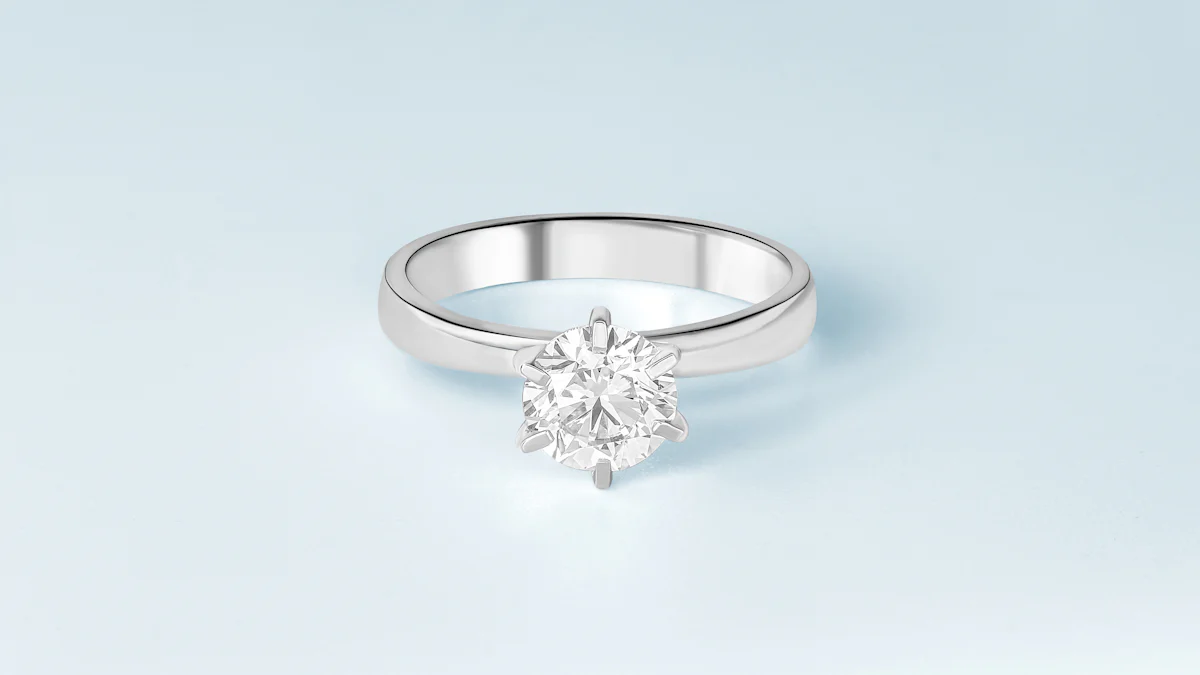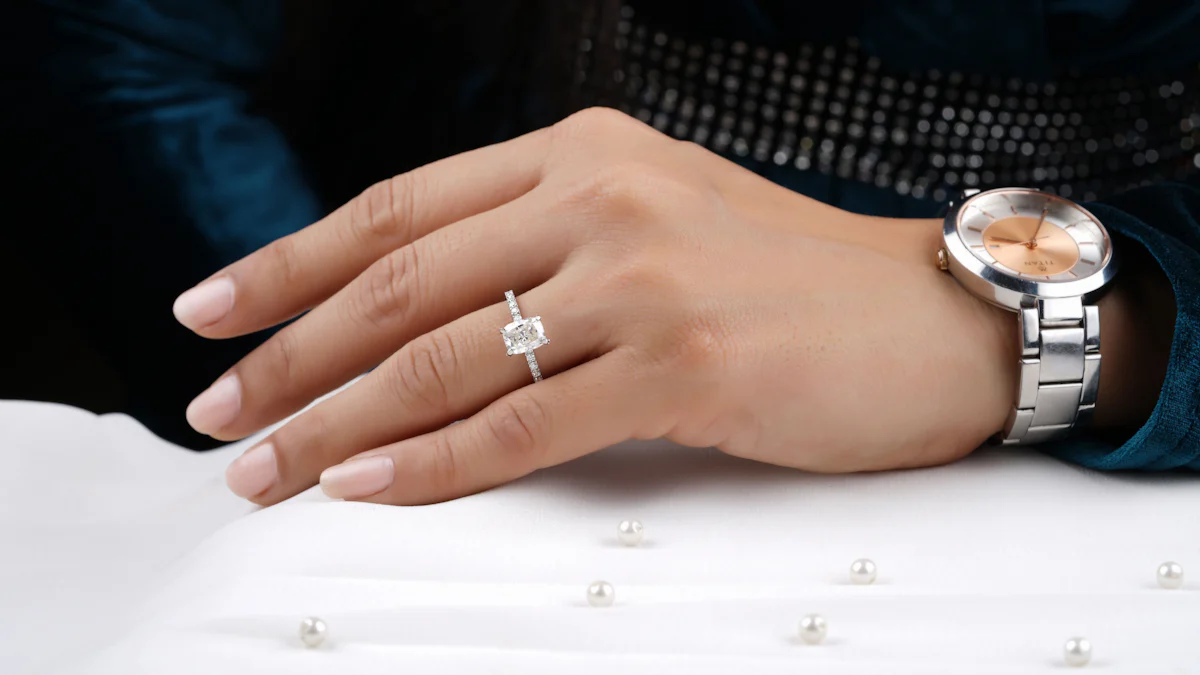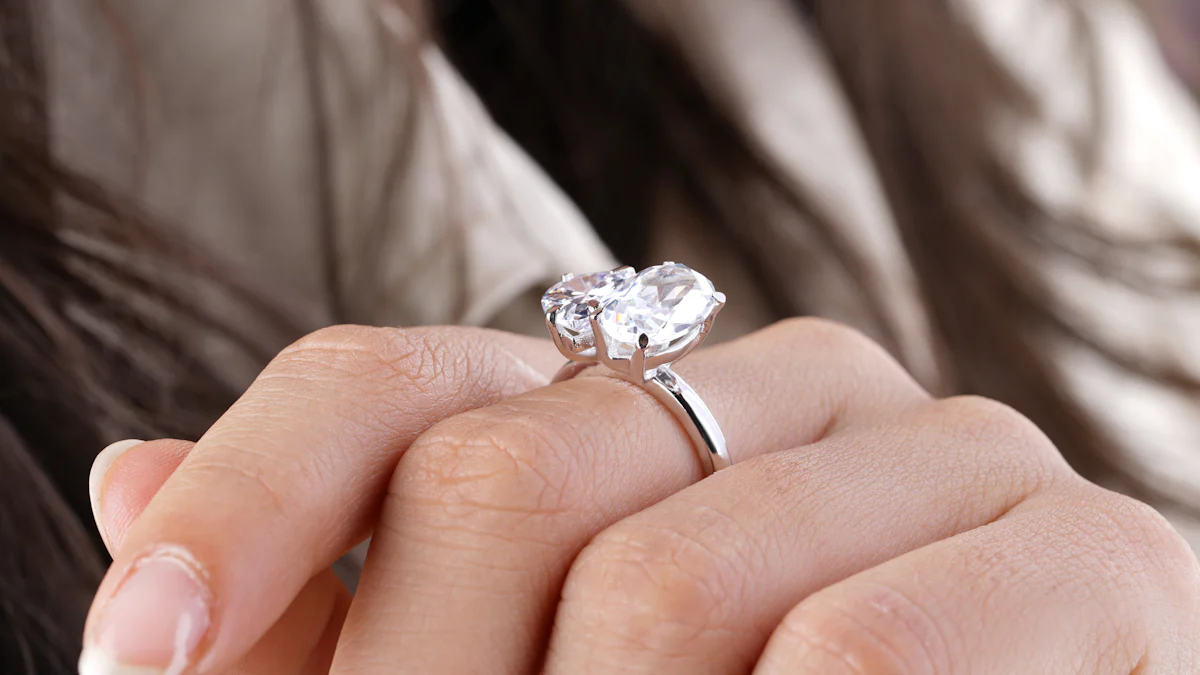Top Tips for Buying a 2 Carat Diamond Solitaire Ring

Buying a 2 carat diamond solitaire ring is an exhilarating experience. This stunning piece of jewelry symbolizes love and commitment, making it a perfect choice for an engagement ring. However, understanding the key factors when purchasing online is crucial. The price of a 2-carat diamond can range from $13,405 to $31,413, depending on its quality. You want to ensure that your investment reflects both beauty and value. By grasping the essentials of buying a diamond, you can confidently select a diamond engagement ring that dazzles and delights.
Understanding the 4Cs of Buying a Diamond

When you're on the hunt for a 2 carat diamond solitaire ring, understanding the 4Cs of diamond quality is crucial. These four factors—color, clarity, cut, and carat—determine a diamond's value and beauty. Let's dive into each one to help you make an informed decision.
Color
Color plays a significant role in a diamond's appearance. The less color a diamond has, the more valuable it is. Diamonds are graded on a scale from D (colorless) to Z (light color). A colorless diamond allows more light to pass through, enhancing its sparkle. When choosing a diamond, aim for a grade between D and J for a balance of beauty and value. Remember, the color can affect the overall look of your ring, especially when paired with different metals.
Clarity
Clarity refers to the presence of internal or external imperfections, known as inclusions and blemishes. The fewer the imperfections, the higher the clarity grade. Diamonds are graded from Flawless (no inclusions visible under 10x magnification) to Included (inclusions visible to the naked eye). While flawless diamonds are rare and expensive, you can find beautiful diamonds with slight inclusions that are not visible without magnification. Consider clarity as a way to balance your budget while still getting a stunning diamond.
Cut
The cut of a diamond is perhaps the most critical factor in determining its brilliance. A well-cut diamond reflects light beautifully, creating that iconic sparkle. The cut grade ranges from Excellent to Poor. An excellent or very good cut will maximize the diamond's natural brilliance and make it appear larger. When shopping, prioritize the cut to ensure your diamond shines brightly. This aspect of the four Cs of diamond grading can significantly impact the overall allure of your ring.
Understanding these aspects of diamond education will guide you in selecting a diamond that meets your expectations. By focusing on the 4Cs of diamond quality, you can find a natural diamond that offers both beauty and value. Keep these tips in mind as you explore your options, and you'll be well on your way to finding the perfect diamond solitaire ring.
Carat
When it comes to diamonds, the term "carat" often gets tossed around. But what does it really mean? Carat refers to the weight of the diamond, not its size. One carat equals 200 milligrams. So, a 2 carat diamond weighs 400 milligrams. The carat weight can significantly impact the price of the diamond. Larger diamonds are rarer, making them more valuable.
However, don't just focus on carat weight alone. A larger diamond doesn't always mean a better diamond. You need to consider the other 4Cs—color, clarity, and cut—alongside carat. A well-cut diamond with excellent clarity and color can appear more brilliant than a larger diamond with poor quality in these areas.
When you're shopping for a 2 carat diamond solitaire ring, think about what matters most to you. Do you want a larger diamond that might have slight inclusions, or would you prefer a smaller diamond with perfect clarity? Balancing these factors will help you find a diamond that fits your budget and meets your expectations.
Remember, the carat weight is just one part of the diamond's story. By understanding how it interacts with the other 4Cs, you can make a more informed decision. This knowledge will guide you in choosing a diamond that truly shines.
Choosing the Right Diamond Shape and Setting

When selecting a 2 carat diamond solitaire ring, the shape and setting play pivotal roles in defining its overall look and feel. These choices reflect your personal style and can enhance the diamond's natural beauty.
Popular Diamond Shapes
The shape of a diamond significantly influences its appearance and how it catches the light. Here are some popular shapes to consider:
-
Round: Known for its timeless appeal and maximum sparkle, the round diamond is a classic choice. Its symmetrical shape allows for optimal light reflection, making it a favorite among many.
-
Princess: This square-shaped diamond offers a modern twist with its sharp angles and brilliant facets. It combines contemporary style with a touch of elegance.
-
Oval: The elongated shape of an oval diamond creates an illusion of greater size. It offers a unique blend of traditional and modern aesthetics.
-
Emerald: With its rectangular shape and step-cut facets, the emerald diamond exudes sophistication. It highlights clarity and color, offering a vintage charm.
-
Cushion: This shape features rounded corners and larger facets, enhancing the diamond's brilliance. It's a romantic choice with a soft, pillow-like appearance.
Choosing the right shape depends on your personal preference and the statement you wish to make. Each shape has its own allure and can complement different styles and personalities.
Selecting the Perfect Setting
The setting of a diamond ring not only secures the stone but also enhances its beauty. Here are some popular settings to consider:
-
Prong: This classic setting uses metal prongs to hold the diamond in place. It allows maximum light exposure, enhancing the diamond's sparkle.
-
Bezel: A bezel setting encircles the diamond with a thin metal rim. It offers a sleek and modern look while providing excellent protection for the stone.
-
Halo: This setting surrounds the center diamond with smaller diamonds, creating a halo effect. It adds extra sparkle and can make the center diamond appear larger.
-
Pavé: Tiny diamonds are set closely together along the band, creating a continuous sparkle. This setting adds a touch of glamour and elegance.
-
Tension: The diamond appears to float between two ends of the band in a tension setting. It's a contemporary choice that showcases the diamond in a unique way.
Selecting the perfect setting involves considering both aesthetics and practicality. Think about your lifestyle and how often you'll wear the ring. A secure setting ensures your diamond stays safe while still looking stunning.
By understanding the different shapes and settings, you can choose a diamond ring that truly reflects your style and personality. Whether you prefer a classic round shape or a modern tension setting, the right combination will make your diamond solitaire ring a cherished piece for years to come.
Selecting the Metal for the Band
Choosing the right metal for your diamond solitaire ring band is just as important as selecting the diamond itself. The metal not only affects the ring's appearance but also its durability and how it complements the diamond. Let's explore your options.
Metal Options
When it comes to metals, you have several choices, each with its own unique characteristics:
-
Platinum: Known for its strength and natural white sheen, platinum is a popular choice for diamond rings. It doesn't tarnish and holds the diamond securely. Its hypoallergenic properties make it ideal for sensitive skin.
-
White Gold: This metal offers a similar look to platinum but at a lower price point. It's an alloy of gold mixed with white metals like palladium or silver. White gold is often coated with rhodium for extra shine and protection.
-
Yellow Gold: A classic choice, yellow gold has a warm, rich color that pairs beautifully with diamonds. Its timeless appeal makes it a favorite for traditional styles.
-
Rose Gold: This metal has gained popularity for its romantic and vintage look. The pinkish hue comes from a mix of gold and copper. Rose gold complements a variety of skin tones and adds a unique touch to your ring.
-
Palladium: Similar to platinum, palladium is durable and has a natural white color. It's lighter than platinum and offers a modern look.
Matching Metal with Diamond
Matching the metal with your diamond involves considering both aesthetics and practicality. Here are some tips to help you decide:
-
Colorless Diamonds: If your diamond is in the D to F color range, a white metal like platinum or white gold will enhance its brilliance. These metals reflect the diamond's sparkle without adding any color.
-
Near-Colorless Diamonds: For diamonds in the G to J range, yellow or rose gold can complement the stone's slight warmth. These metals can enhance the diamond's natural beauty and create a harmonious look.
-
Vintage Appeal: If you're going for a vintage style, rose gold or yellow gold can add a touch of nostalgia. These metals pair well with cushion or emerald-cut diamonds, which often feature in vintage designs.
-
Modern Look: For a contemporary feel, consider platinum or white gold. These metals work well with round or princess-cut diamonds, known for their modern elegance.
Selecting the right metal for your diamond ring band is a personal choice. Consider your lifestyle, skin tone, and the overall look you want to achieve. By choosing a metal that complements your diamond, you'll create a stunning ring that you'll cherish for years.
Ensuring a Safe Purchase When You Buy Diamonds Online
Buying diamonds online can be a thrilling experience, but you need to ensure that your purchase is safe and secure. Here are some essential tips to guide you through the process.
Choosing a Reputable Jeweler
When you decide to buy diamonds online, picking a reputable jeweler is crucial. A trustworthy jeweler will provide you with high-quality diamonds and excellent customer service. Here’s how you can identify a reputable jeweler:
-
Research: Start by reading reviews and testimonials from previous customers. Look for jewelers with a strong online presence and positive feedback.
-
Certifications: Check if the jeweler is certified by recognized organizations such as the Gemological Institute of America (GIA) or the American Gem Society (AGS). These certifications indicate that the jeweler adheres to industry standards.
-
Transparency: A reputable jeweler will offer detailed information about their diamonds, including the 4Cs—color, clarity, cut, and carat. They should also provide clear images and videos of the diamonds.
-
Customer Service: Good customer service is a hallmark of a reputable jeweler. They should be responsive to your inquiries and willing to provide additional information or assistance.
By taking these steps, you can confidently pick a reputable jeweler and ensure a safe online purchase.
Obtaining a Diamond Grading Report
When you buy diamonds online, insist on a diamond grading report. This report is essential for verifying the quality and authenticity of your diamond. Here’s why it matters:
-
Verification: A diamond grading report provides an unbiased assessment of the diamond's quality. It includes details about the diamond's color, clarity, cut, and carat weight.
-
Trust: Insisting on a diamond grading report builds trust between you and the jeweler. It shows that the jeweler is transparent about the diamond's characteristics.
-
Value: The report helps you understand the value of the diamond. It ensures that you are paying a fair price based on the diamond's quality.
-
Resale: If you ever decide to sell or upgrade your diamond, a grading report will be invaluable. It serves as proof of the diamond's quality and can enhance its resale value.
Always insist on a diamond grading report from a reputable grading laboratory like GIA or AGS. This report will give you peace of mind and ensure that your diamond purchase is a wise investment.
By following these tips, you can navigate the online diamond market with confidence. Remember to pick a reputable jeweler and insist on a diamond grading report to ensure a safe and satisfying purchase.
When buying a 2 carat diamond solitaire ring, remember the importance of the 4Cs: color, clarity, cut, and carat. These factors shape the diamond's beauty and value. Also, consider the shape, setting, and metal choice to match your personal style. Always purchase from a reputable jeweler to ensure quality and authenticity. Online shopping offers convenience and variety, but being well-informed is key. Trustworthy vendors provide detailed imagery and expert guidance. With these tips, you can confidently select an engagement ring that dazzles and delights.
FAQ
What are the 4Cs of a diamond?
The 4Cs stand for Color, Clarity, Cut, and Carat. These factors determine a diamond's quality and value. Understanding them helps you make an informed decision when purchasing a diamond. Color refers to the absence of color in a diamond. Clarity measures the presence of imperfections. Cut evaluates how well the diamond reflects light. Carat indicates the weight of the diamond.
How do I choose the right diamond shape?
Choosing the right diamond shape depends on personal preference and style. Popular shapes include round, princess, oval, emerald, and cushion. Each shape has unique characteristics. Round diamonds offer maximum sparkle. Princess cuts provide a modern look. Oval shapes create an illusion of size. Emerald cuts highlight clarity. Cushion shapes have a romantic appeal.
Why is the cut of a diamond important?
The cut of a diamond is crucial because it affects the diamond's brilliance. A well-cut diamond reflects light beautifully, creating sparkle. The cut grade ranges from Excellent to Poor. Prioritizing a good cut ensures your diamond shines brightly and appears larger.
How can I ensure a safe online diamond purchase?
To ensure a safe online diamond purchase, choose a reputable jeweler. Look for certifications from recognized organizations like GIA or AGS. Read customer reviews and testimonials. Insist on a diamond grading report to verify quality. Ensure the jeweler provides detailed images and videos of the diamond.
What is a diamond grading report?
A diamond grading report is an unbiased assessment of a diamond's quality. It includes details about the diamond's color, clarity, cut, and carat weight. This report helps you understand the diamond's value and ensures you pay a fair price. Always request a grading report from a reputable laboratory like GIA or AGS.
How does metal choice affect a diamond ring?
The metal choice affects the ring's appearance and durability. Popular metals include platinum, white gold, yellow gold, rose gold, and palladium. Platinum offers strength and a natural white sheen. White gold provides a similar look at a lower price. Yellow gold has a classic appeal. Rose gold adds a romantic touch. Palladium offers a modern look.
Can I return a diamond ring if I buy it online?
Most reputable online jewelers offer a return policy. Check the return policy before purchasing. A flexible return policy provides peace of mind if the ring doesn't meet your expectations. Ensure you understand the terms and conditions of the return process.
What should I consider when setting a budget for a diamond ring?
When setting a budget, consider the 4Cs: color, clarity, cut, and carat. These factors influence the diamond's price. Decide which aspects are most important to you. Balance your preferences with your financial situation. Use online tools like diamond price calculators to help you make informed decisions.
Are lab-grown diamonds a good option?
Lab-grown diamonds offer a more affordable option without compromising quality. They have the same physical and chemical properties as natural diamonds. Consider lab-grown diamonds if you're looking for a budget-friendly choice. They provide excellent value and are an ethical alternative.
See Also
A Comprehensive Approach to Selecting a White Diamond Ring
An All-Inclusive Manual for Choosing the Ideal Diamond Ruby Ring
Essential Elements to Consider When Pricing Diamond Rings
Tips for Selling Your Diamond Ring at Its Highest Price
Ultimate Guide to Selecting a Single Ring for Engagement and Wedding

